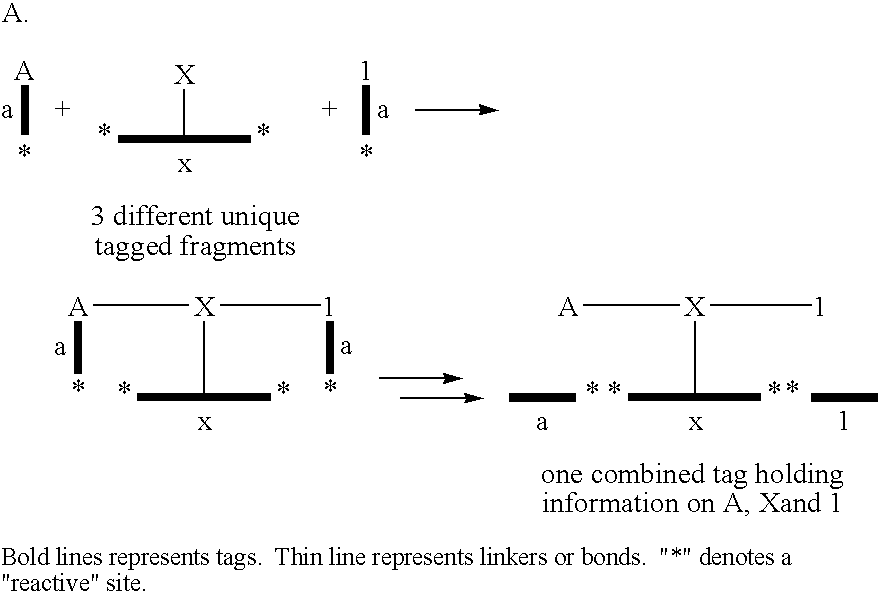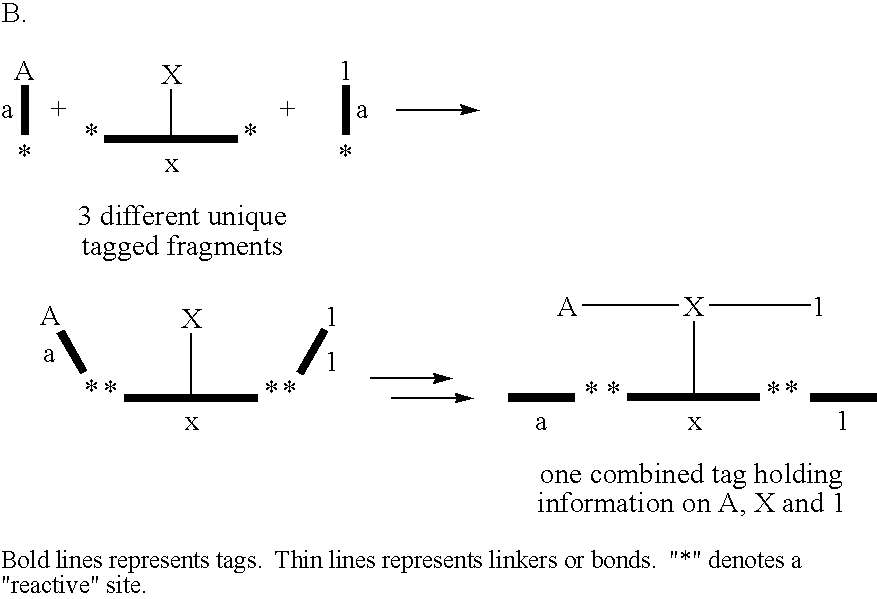Method for selecting a chemical entity from a tagged library
a chemical entity and library technology, applied in the field of determining the identity of a chemical entity, to achieve the effect of increasing stringency conditions, increasing temperature, acidity, and alkalinity
- Summary
- Abstract
- Description
- Claims
- Application Information
AI Technical Summary
Benefits of technology
Problems solved by technology
Method used
Image
Examples
example 1
Loading of Entity onto Tag
Procedure:
[0122] 25 μL of a 150 mM building block solution in DMF was mixed with 25 μL of a 150 mM solution of EDC in DMF. The mixture was left for 30 min at 25° C. 50 μL of an aminooligo (10 nmol) in 100 mM HEPES buffer pH 7.5 was added and the reaction mixture was left for 20 min at 25° C. The excess building block was removed by extraction with EtOAc (500 μL). The excess EtOAC was removed at reduced pressure in a speedvac. The building block loaded aminooligo was ethanol precipitated twice using NH4OAc and analysed by electron spray mass spectrometry (ES-MS).
example 2
[0123] The following example illustrates the use of the tagging principle for the identification of entities comprising desirable properties isolated from a library of entities. The principle is shown schematically in FIG. 1.
[0124] DNA-tagging of peptides for the identification of complexes that bind the integrin receptor αV / β3.
Materials:
[0125] Purified human integrin αV / β3 (Chemicon Inc.) [0126] Streptavidin Sepharose 6B (AmershamPharmacia) [0127] Nunc Immunomodule U8 Maxisorp (Biotecline cat# Nun-475078) [0128] Sheared herring DNA (Sigma) [0129] Taq-polymerase (Promega) and 10×Taq-pol buffer [0130] Binding buffer [100 mM NaCl, 5 mM MgCl2, 50 mM Tris-HCl, pH 7.5][0131] UV-transilluminator [0132] SPDP [N-succinimidyl 3(2-pyridyldithio)propionate] (Molecular Probes, Cat: S-1531) [0133] Micro Bio-Spin 6 (Bio-Rad cat: 732-6221)
[0134] 6 tagging oligo nucleotides with the following sequences:
TO#1: 5′-XCTATGCGGACTGACTGGTAC-3′TO#2: 5′-XCTATGATGCTTAGGCGGTAC-3′TO#3: 5′-XCTATGTACCGTACG...
example 3
[0161] The following example illustrates the use of the tagging principle for the identification of a DNA sequence representing a small molecule isolated from a library of sequences. The principle is shown schematically in the figures.
DNA-Tagging of Biotin and Glutathione for the Identification of Complexes that Bind Streptavidine.
Materials:
[0162] Streptavidin Sepharose 6B (AmershamPharmacia) [0163] Taq-polymerase (Promega) and 10×Taq-pol buffer [0164] Binding buffer [100 mM NaCl, 5 mM MgCl2, 50 mM Tris-HCl, pH 7.5]; [0165] SPDP [N-succinimidyl 3(2-pyridyldithio)propionate] (Molecular Probes, Cat: S-1531) [0166] N-hydroxysuccinimidylester-biotin (Fluka#14405) [0167] Glutathione (Sigma) [0168] Micro Bio-Spin 6 (Bio-Rad cat: 732-6221) [0169] T7 Exonuclease (gene 6) and 5× buffer
[0170] Tagging oligo nucleotides with the following sequences:
TO#1: 5′-XCTATGCGGACTGACTGGTAC-3′TO#2: 5′-XCTATGANNNNNNNNCGGTAC-3′,(65.536 sequence combinations)
where X=5′ C6 amino modifier (Glen researc...
PUM
| Property | Measurement | Unit |
|---|---|---|
| molecular weight | aaaaa | aaaaa |
| pH | aaaaa | aaaaa |
| total volume | aaaaa | aaaaa |
Abstract
Description
Claims
Application Information
 Login to View More
Login to View More - R&D
- Intellectual Property
- Life Sciences
- Materials
- Tech Scout
- Unparalleled Data Quality
- Higher Quality Content
- 60% Fewer Hallucinations
Browse by: Latest US Patents, China's latest patents, Technical Efficacy Thesaurus, Application Domain, Technology Topic, Popular Technical Reports.
© 2025 PatSnap. All rights reserved.Legal|Privacy policy|Modern Slavery Act Transparency Statement|Sitemap|About US| Contact US: help@patsnap.com



